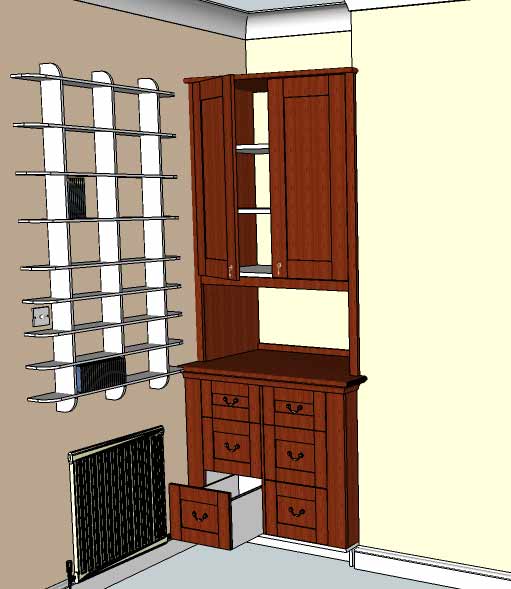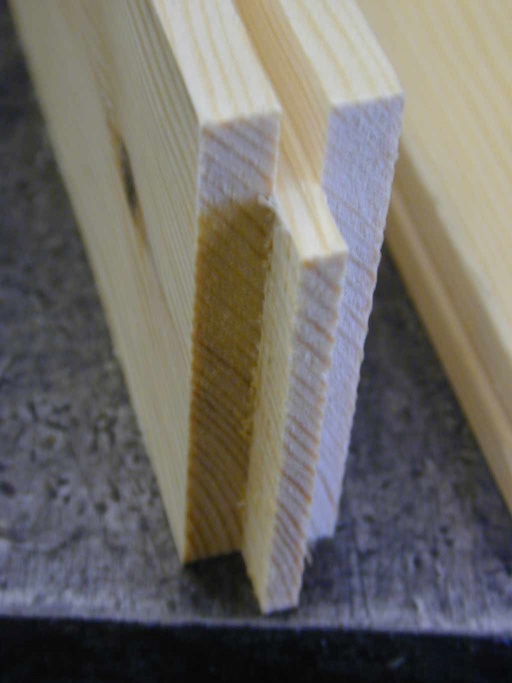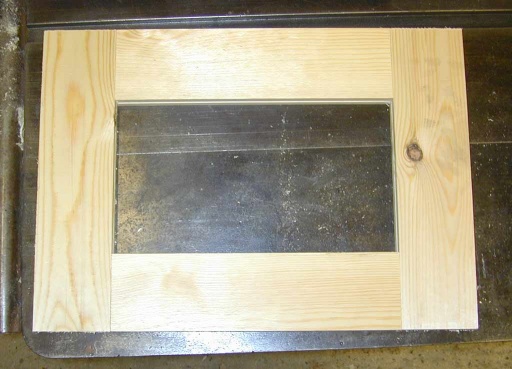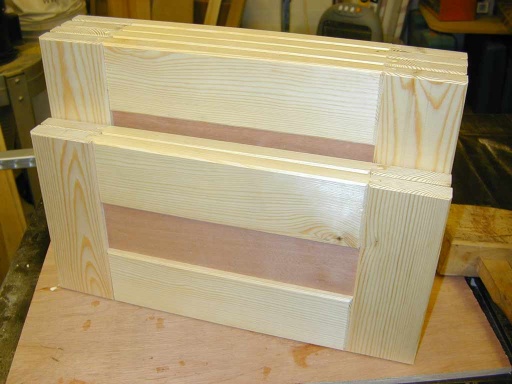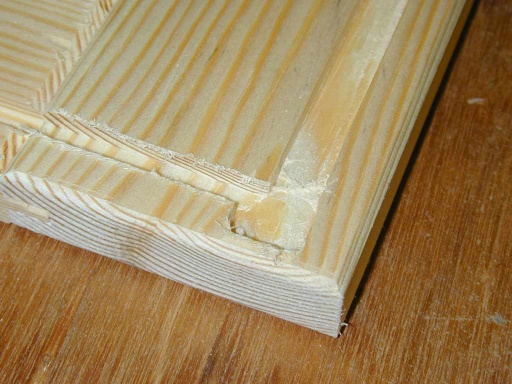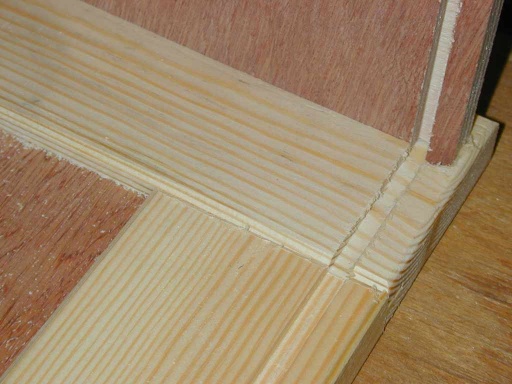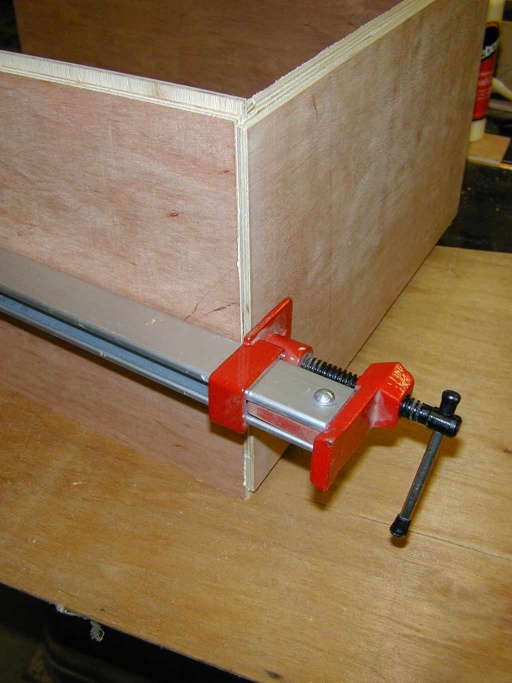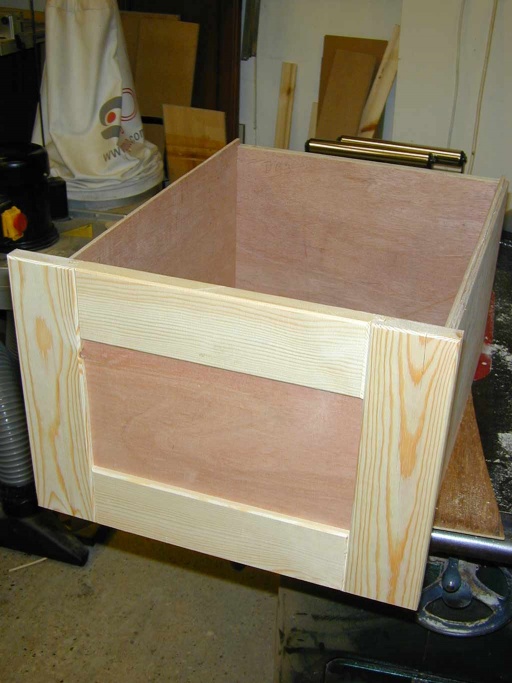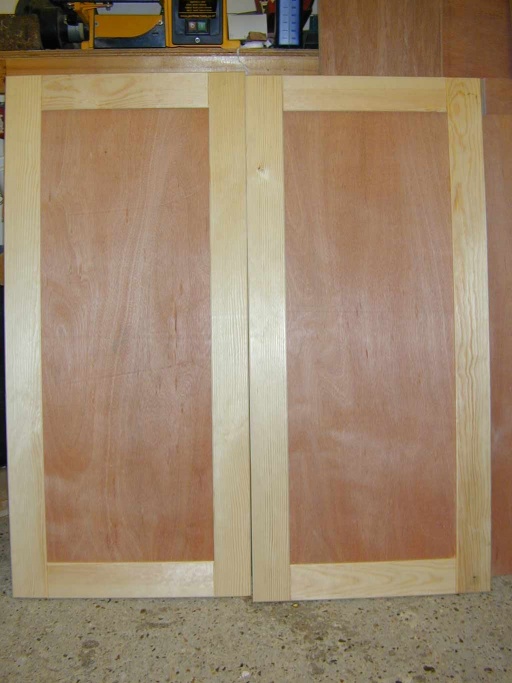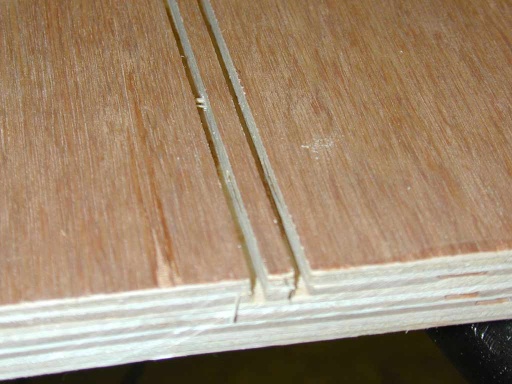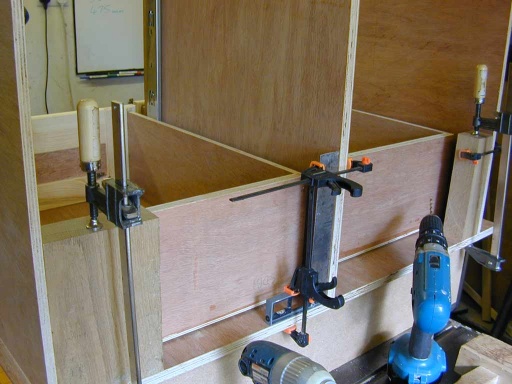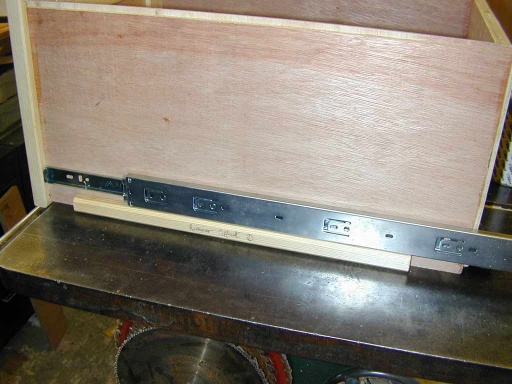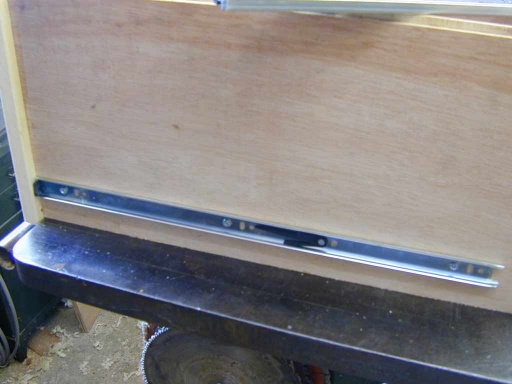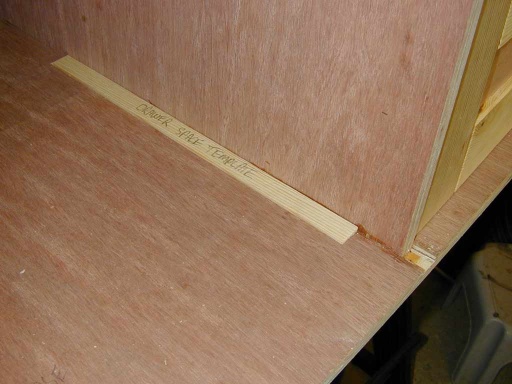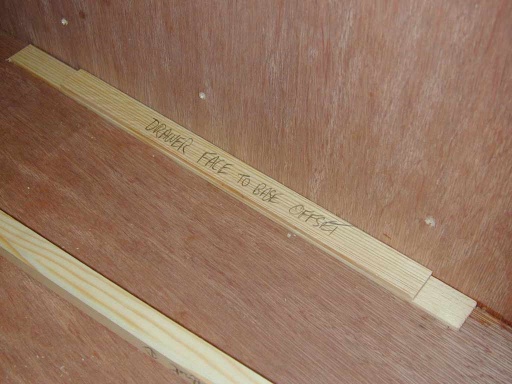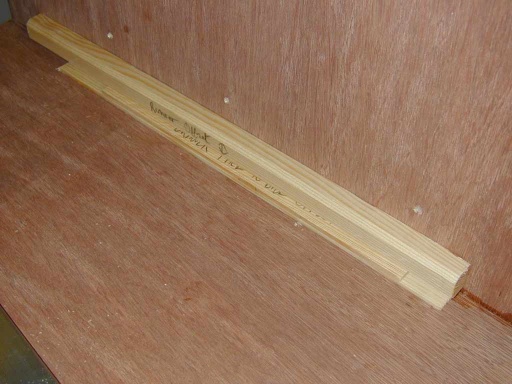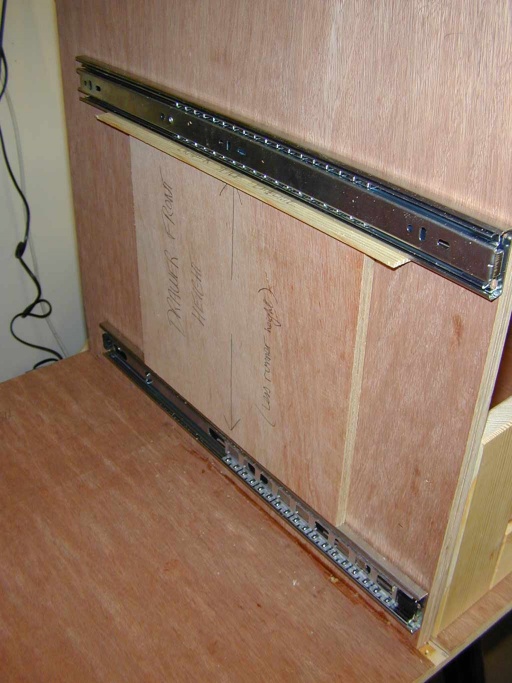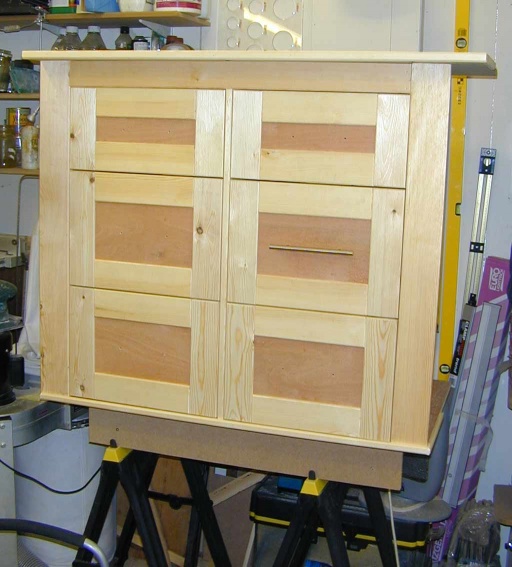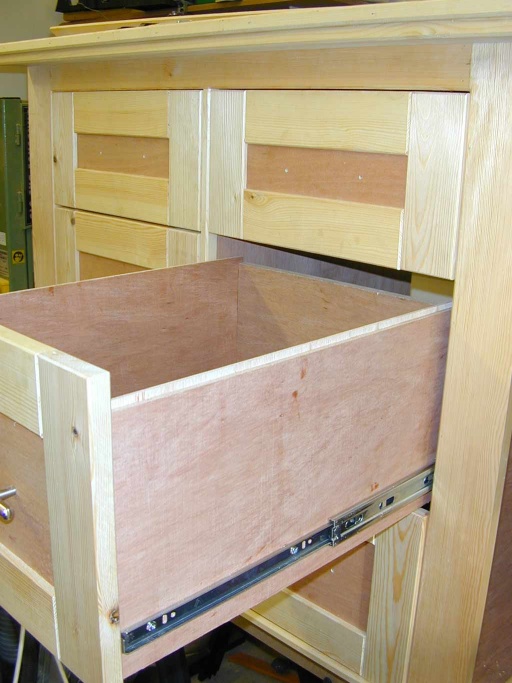Built in office furniture
Introduction
This article gives an illustration of how to build some bespoke furniture. In this case it was intended for use in a home office or study, but the principles would work equally well in other locations.
Design
The design goal here was to take an office that is too small, and full of too much stuff, and better organise it! One of the key problems was the rear corner. In an alcove beside a chimney breast, there was a tatty old cupboard, and a 4 drawer filing cabinet, with a few shelves above. In front of that was another tatty cabinet, and a spare kitchen cabinet fixed to the wall above it that had been found in the garage when we moved in, and pressed into service to add some more storage space. The end result was a bit of a mess, and not at all easy to get at.
So the design was approached with the obligatory sketchup model (see above). It was to have 4 filing drawers to replace the metal filing cabinet, plus a couple more of big drawers for "stuff". Above this was to be a cupboard unit, but lifted clear of the top of the base unit to provide some workspace ig enough to hold a computer or monitor or similar sized kit. The cupboard space was intended to be substantial, and take the total combined height to around 9' tall! The unit was to fill the total width of the alcove at around 3'6".
The first design was conceived as a hardwood, French polished affair. However that was soon rejected on the grounds that it would not suite the location as well, and the cost of the materials would be rather steep fro what after all is in an office! So a softwood / ply / and painted finish was adopted instead...
Materials
2 sheets of 18mm WBP ply, 2 sheets of 12mm ply, 1 sheet 6mm MDF, 1 sheet 6mm ply, 1/2 Sheet of 18mm MDF, 4 of 2.4m lengths of 9"x1" PAR softwood, 1 2m length of 7 x 3/4" PAR, six heavy duty drawer runners (ebay), and handles & hinges etc.
Construction
The drawers and cupboard doors are both built using the same technique. A face frame is made up from 3" / 75mm softwood rails and stiles, and the inset panel is simply 6mm ply.
Drawers
The drawers were the first thing that deviated from the original design a little. Since it was felt that the filing cabinet ones would need decent substantial runners to work well, a set of three part full extension runners were bought. The original drawer design was to be a simple box construction, however the addition of the runners meant that the drawer front now needed to be widened by 1/" inch either side to cover the thickness of the runners.
A couple of planks of the 9x1" PAR were ripped down to provide a couple of lengths of 75mm wide timber, plus some left over strips to be used for lipping the ply wood later. The stiles were then cut to full length for each drawer front from this, and the rails were cut 20mm over length to allow for the tenon sections at the ends.
All the joinery was to be cut on the table saw. First job, measure the thickness of the 6mm ply. This actually turned out to be about 4.7mm! Hence just under 5mm was the require size for the rebate to hole the ply panel, and would also be used for the face frame joinery. The fence was carefully set up on the saw to allow the timber to be passed over the blade (raised about 11mm), to leave a 3mm kerf, offset to one side slightly. Flipping the timber round, and making the same cut again but from the other end provided a dead centre rebate of the required 5mm. This was repeated for all the inside edges of the rails and stiles.
The tenon section was then cut using a similar technique but with the timber flat on the table to cut the shoulders. A couple of extra passes over the blade then removed the remaining waste:
A test fit of the drawer frame came out like this:
To add a little interest to the frame, a small 45 degree chamfer bit was used in a trim router to add an edge detail to all the edges. This was also done at the joint intersections so that it would leave a vee groove detail in the finished frame. Finally the ply insert panel was cut, and the drawer fronts glued up and assembled. A frame clamp was used to pull them all together, however once assembled the tenons held everything firm enough to not require further clamping. The completed fronts:
The backs of the drawer fronts were then routed to accept the sides and base. The base was to be in the thin ply, and the sides in the 12mm ply:
This was done with a hand held router, and a fence to provide a 1/2" offset from the sides of the drawer. First all the drawers were routed with a 6mm bit, and then the sides were re routed with the same bit at a bigger offset to enlarge the dado to take the wider ply sides.
The ply for the sides, back and base was also cut. The sides needed to be grooved to accept the base (done with two non through cuts on the table saw), ans also the filing cabinet drawers also had a section notched out of the outside top edges, to leave "rails" that the suspension files could sit on.
The ply sides are deliberately shorter than the drawer front to allow clearance for labels on the tops of the suspension files.
The drawer back was cut from 18mm ply to the full width of the drawer, and a couple of cuts on the table saw were used to take a 1/2" square notch out the inside vertical edges of the drawer. This created a rebate that the edge of the drawer side could sit in. The height was slightly less than that of the sides to allow for the fact the back only reaches down as far as the top of the drawer base which was to be inserted last.
The first bit of assembly was to glue the sides into the rebate in the drawer front:
Then a couple of scraps of thin ply were set in the base groove to provide alignment of the back, and the back panel glued up and placed into position on the ends of the sides. This was then clamped tight along the length, and 30mm 18g brad nails shot into the corner joint from the back, pinning it tightly together:
The clamp was then placed across the draw and that joint nailed when pulled up tight as well. Once completed the drawers looked like:
Doors
Since the the cupboard door design was essentially just a very large drawer front, these were completed at this stage as well, using the same techniques:
Base Unit
The base unit is a simple affair with a plinth, and then 5 boards to make a bottom, top, two sides, and a central divider. The plinth was simply a large H section cut from some scrap 1/2" MDF. This was designed to be a little less deep than the whole unit to allow a small kick space under the front of it.
The base was then cut from the thick ply, as was the central divider (since this was to have drawer runners screwed to both sides of it, the thicker stock meant there was less likely to be a problem with screws hitting each other!).
Dados were then cut in the base to house the vertical boards. Since these were somewhat under sized ply, these were cut as a pair of carefully laid out saw kerfs, and then the central section simply snapped out with the edge of a card scraper:
(being ply, the small central section de-laminates without too much protest!)
The base board was then screwed to the plinth, and the sides and central boards glued up and inserted. Two of the drawers and their runners were also put in place to make absolutely sure the spacing was going to be right! Some blocks of wood were also clamped into the corners while the glue set to make sure the whole construction at least started out square:
Finally, matching dados were cut into the underside of the worktop (3/4" MDF), and then that was glued up and dropped into place on the tops of the verticals. (the dados were cut to be a nice snug fit, so that it could be tapped home with a large hammer!)
(note the top has a wider overhang on the right hand side - this is to allow it to be fitted around the corner of the chimney breast at a later stage).
One of the last stages of the base unit construction was to make the face frame, and to cut lippings from some of the left over strips of PAR softwood. There were cut to size on the table saw, planed off by hand and then glued and brad nailed to the edges through the face. (the pressure on the nailer was turned up a bit to make sure the nails were punched well under). These holes would be filled later. The same 45 degree chamfer bit was also used to detail the edges of the lippings as had been used for the drawer ans cupboard edges. The frame and lippings cover the edges of the ply and also create the additional "width" required either side of the drawers to fill the left over space (and make sure the drawers open past the radiator on the adjacent wall!)
The final and most tricky job was fitting the drawer runners to the drawers and the carcass. This was done with a number of spacer blocks cut for the purpose, to ensure the same positions could be achieved each time. First the inner section was fixed to each drawer:
The drawer runner could be opened a little and the first screw fixed, then progressively slid more open and the others inserted. Until finally the catch could be flipped to release the inner runner altogether:
Next you need three templates to get the first runner in place in the cabinet, the first gives the offset from the base of the drawer front to the base of its sides (remember the face frame of the drawer front under hangs the bottom of the sides a small amount (as you can see from the extra screw holes in the side in a later photo - I forgot this the first time round!)
Next you need a spacer equal to the space that you want between each drawer. I used one of about 3mm here since the drawers could end up being quite heavy when fully loaded, and I wanted to make sure they stayed clear of each other!
Finally, the same template used for setting the height of the runner on the side of the drawer itself was reused to allow for the distance from the base of the drawer side to the runner:
That gets the first four runners in place. Now you need one more template to space the next runner one drawers height higher, this is used with the drawer spacing template to puch the next runner up by a drawer height and a drawer gap height:
The same trick is used for the top runners as well since although they are shorter, they are still a "big drawer" higher.
Apart from and extra strip of wood added later to add some more "weight" to the edge of the worktop, the addition of a lipping to the edged of the worktop, means that is the base unit basically done:
A template was made from a scrap of ply to drill the holes for the drawer handles. And one test fitted to make sure all works as expected:
You can see the three part runners allow access to pretty much all of the drawer.
